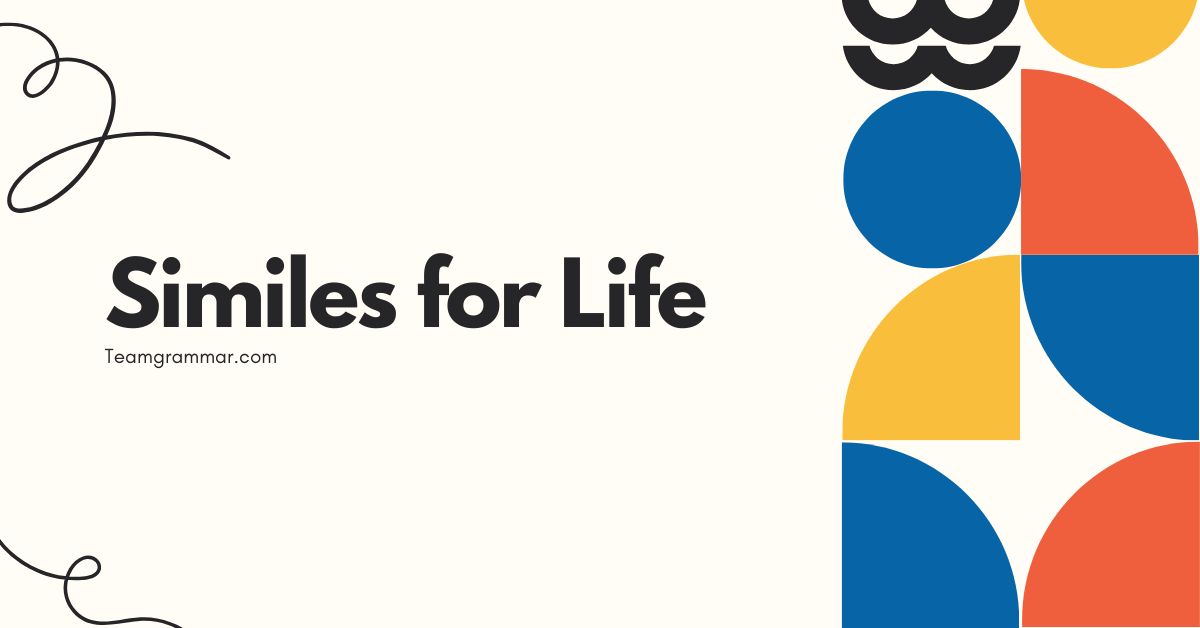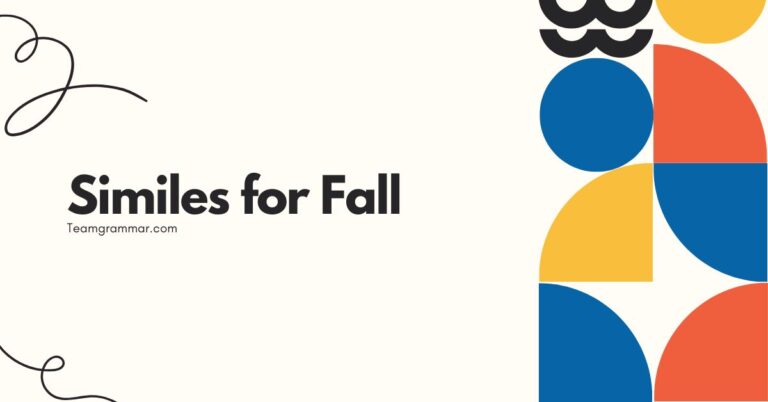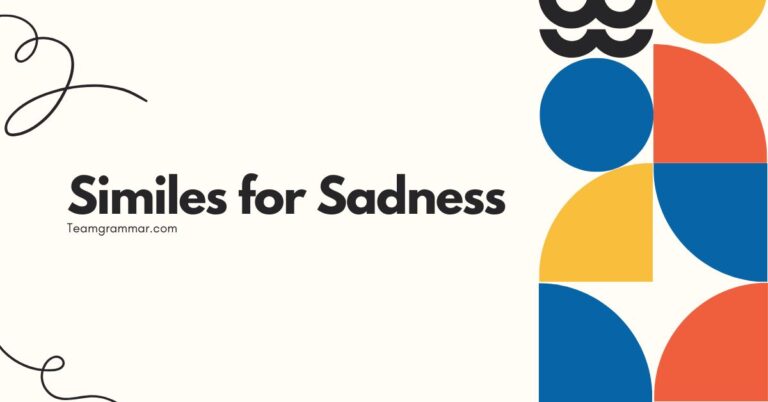37 Similes for Life: Mastering Figurative Language
Similes are powerful tools in the English language that enrich our communication by drawing comparisons between seemingly unrelated things. Understanding similes enhances both our writing and comprehension skills, allowing us to express ideas more vividly and appreciate the nuances of figurative language.
This article provides a comprehensive guide to similes, exploring their definition, structure, types, usage rules, and common mistakes. Whether you’re a student, writer, or language enthusiast, this guide will equip you with the knowledge and practice to master similes and use them effectively in your everyday communication.
Table of Contents
- Introduction
- Definition of Similes
- Structural Breakdown
- Types of Similes
- Examples of Similes
- Usage Rules
- Common Mistakes
- Practice Exercises
- Advanced Topics
- FAQ
- Conclusion
Definition of Similes
A simile is a figure of speech that directly compares two different things, highlighting a shared quality. It is a type of metaphor, but unlike metaphors, similes always use specific words to make the comparison, such as”like”or”as.”Similes serve to make descriptions more vivid, engaging, and relatable by drawing parallels between familiar concepts and unfamiliar ones.
They add depth and color to language, making it more expressive and memorable. Understanding similes is crucial for interpreting literature, poetry, and everyday conversations, as they are frequently used to convey nuanced meanings and create striking imagery.
Similes function as a tool for enhancing communication by creating a clearer and more impactful understanding of a subject. They do this by relating the subject to something the audience is already familiar with.
The effectiveness of a simile lies in its ability to evoke a strong mental image or emotional response by linking two distinct entities. The context in which a simile is used is also important.
The same simile can have different effects depending on the surrounding words and the overall tone of the communication.
Structural Breakdown
The basic structure of a simile involves three key components: thesubject(the thing being described), thelinking word(either “like” or “as”), and theobject of comparison(the thing the subject is being compared to). This structure allows for a clear and direct comparison, making it easy for the audience to understand the intended meaning.
The order of these components is typically consistent, but variations can occur to create different effects or emphasize certain aspects of the comparison.
Let’s break down the structure with examples:
- Subject: The person, thing, or idea being described. Example: “Her smile”
- Linking Word: The word that establishes the comparison. Example: “as” or “like”
- Object of Comparison: The person, thing, or idea the subject is being compared to. Example: “the sun”
Putting it together: “Her smile was as bright as the sun.” Here, “Her smile” is the subject, “as” is the linking word, and “the sun” is the object of comparison.
Another example: “He eats like a horse.” Here, “He” is the subject, “like” is the linking word, and “a horse” is the object of comparison.
Types of Similes
Similes can be categorized based on the type of comparison they make and the effect they create. Understanding these categories can help you choose the most appropriate simile for your specific purpose.
Common categories include positive similes, negative similes, and ironic similes.
Positive Similes
Positive similes are used to highlight desirable qualities or characteristics of the subject. These similes often evoke positive emotions and create a favorable impression.
They are frequently used in compliments, praise, and descriptions that aim to emphasize the positive aspects of something. The comparison is usually made to something that is widely considered to be positive or desirable.
Examples of positive similes include:
- “She is as radiant as the morning sun.”
- “He is as brave as a lion.”
- “The music was as soothing as a gentle breeze.”
Negative Similes
Negative similes, conversely, are used to highlight undesirable qualities or characteristics of the subject. These similes often evoke negative emotions and create an unfavorable impression.
They are frequently used in criticisms, complaints, and descriptions that aim to emphasize the negative aspects of something. The comparison is usually made to something that is widely considered to be negative or undesirable.
Examples of negative similes include:
- “He is as stubborn as a mule.”
- “The food tasted like cardboard.”
- “She is as cold as ice.”
Ironic Similes
Ironic similes are used to create a contrast between what is said and what is actually meant. These similes often involve comparing the subject to something that is seemingly positive or desirable, but in reality, the comparison highlights a negative or undesirable quality.
Ironic similes are often used for humorous or satirical effect.
Examples of ironic similes include:
- “He’s about as useful as a chocolate teapot.” (meaning he is not useful at all)
- “She’s as clear as mud.” (meaning she is not clear at all)
- “That’s about as funny as a funeral.” (meaning it’s not funny at all)
Examples of Similes
Similes can be used to describe a wide range of things, including emotions, appearances, behaviors, and objects. The key is to choose a comparison that is both vivid and relevant to the subject.
The following sections provide examples of similes categorized by the type of description they provide.
General Similes
These similes are commonly used in everyday language to describe various aspects of life. They provide a simple yet effective way to enhance communication and create a clearer understanding of the subject.
The table below provides a variety of general similes, showcasing how different subjects can be compared using “like” or “as.” These examples illustrate the versatility of similes in everyday language.
| Simile | Explanation |
|---|---|
| As busy as a bee | Very active and hardworking. |
| As clear as crystal | Very easy to understand. |
| As cold as ice | Completely lacking in warmth or emotion. |
| As different as night and day | Completely dissimilar. |
| As dry as a bone | Completely lacking in moisture. |
| As easy as pie | Very simple and straightforward. |
| As fast as lightning | Very quick. |
| As fit as a fiddle | In excellent physical condition. |
| As gentle as a lamb | Very kind and tender. |
| As happy as a clam | Very content and joyful. |
| As hungry as a bear | Very hungry. |
| As light as a feather | Very lightweight. |
| As meek as a mouse | Very quiet and submissive. |
| As old as the hills | Very old. |
| As quiet as a mouse | Very silent. |
| As red as a rose | Very red. |
| As sharp as a tack | Very intelligent and perceptive. |
| As slow as molasses | Very slow. |
| As smooth as silk | Very smooth to the touch. |
| As tall as a giraffe | Very tall. |
| As tough as nails | Very resilient and strong. |
| As white as snow | Very white. |
| As wise as an owl | Very knowledgeable and insightful. |
| Like two peas in a pod | Very similar to each other. |
| Like a fish out of water | Feeling uncomfortable or out of place. |
| Like a moth to a flame | Being irresistibly drawn to something dangerous or alluring. |
| Like a needle in a haystack | Very difficult to find. |
Similes for Emotions
Similes can effectively convey the intensity and nuances of different emotions. By comparing emotions to tangible things or experiences, we can create a more vivid and relatable understanding of how someone is feeling.
The following table provides examples of similes used to describe various emotions, offering a deeper understanding of how figurative language can express feelings.
| Simile | Explanation |
|---|---|
| As angry as a hornet | Extremely angry and irritable. |
| As anxious as a cat in a room full of rocking chairs | Very nervous and apprehensive. |
| As cheerful as a lark | Very happy and optimistic. |
| As disappointed as a child who didn’t get a gift | Feeling let down and disheartened. |
| As excited as a kid in a candy store | Very enthusiastic and thrilled. |
| As fearful as a mouse in a hawk’s shadow | Very scared and apprehensive. |
| As gloomy as a rainy day | Very sad and depressed. |
| As grateful as a rescued animal | Very thankful and appreciative. |
| As guilty as a thief caught red-handed | Feeling remorseful and ashamed. |
| As hopeful as a sunrise | Feeling optimistic and positive about the future. |
| As insecure as a toddler learning to walk | Lacking confidence and feeling uncertain. |
| As irritated as a mosquito bite | Slightly annoyed and bothered. |
| As jealous as a rival | Feeling envious and resentful. |
| As lonely as a cloud | Feeling isolated and alone. |
| As nervous as a long-tailed cat in a room full of rocking chairs | Very anxious and uneasy. |
| As optimistic as a lottery winner | Feeling very hopeful and positive. |
| As proud as a peacock | Very pleased and self-satisfied. |
| As relaxed as a cat in a sunbeam | Completely calm and at ease. |
| As sad as a broken heart | Feeling very sorrowful and grief-stricken. |
| As surprised as a deer in headlights | Feeling shocked and astonished. |
| As terrified as a person in a haunted house | Feeling extremely frightened and scared. |
| As understanding as a compassionate friend | Feeling empathetic and supportive. |
| As vulnerable as a newborn baby | Feeling exposed and defenseless. |
| As worried as a parent of a sick child | Feeling anxious and concerned. |
| As youthful as a spring day | Feeling energetic and lively. |
| As zealous as a preacher | Feeling very enthusiastic and passionate. |
Similes for Appearance
Appearance is often described using similes to create a more descriptive and imaginative picture. These similes can highlight specific features or provide an overall impression of someone’s physical appearance.
The table below showcases similes used to describe appearance, helping you visualize how these comparisons can make descriptions more vivid and engaging.
| Simile | Explanation |
|---|---|
| As beautiful as a rose | Very attractive and lovely. |
| As pale as a ghost | Having a very white or colorless complexion. |
| As wrinkled as a prune | Having many lines or folds in the skin. |
| As bright as a button | Having a cheerful and lively appearance. |
| As round as a ball | Having a spherical or circular shape. |
| As skinny as a rake | Very thin and bony. |
| As elegant as a swan | Having a graceful and refined appearance. |
| As colorful as a rainbow | Having a vibrant and varied appearance. |
| As radiant as the sun | Having a glowing and healthy appearance. |
| As sharp as a knife | Having well-defined and striking features. |
| As neat as a pin | Having a tidy and well-groomed appearance. |
| As plain as bread | Having an ordinary or unremarkable appearance. |
| As rough as sandpaper | Having a coarse or uneven texture. |
| As shiny as a new penny | Having a bright and polished appearance. |
| As soft as velvet | Having a smooth and gentle texture. |
| As spotless as a mirror | Completely clean and without blemishes. |
| As strong as an ox | Having a robust and powerful physique. |
| As tall as a tree | Having a significant height. |
| As youthful as spring | Having a fresh and vibrant appearance. |
| Like a Greek god | Having a classically handsome and sculpted appearance. |
| Like a porcelain doll | Having a delicate and flawless appearance. |
Similes for Behavior
Similes are also valuable for describing behavior, allowing us to draw comparisons between actions and familiar concepts or entities. This can help to create a more nuanced and descriptive portrayal of someone’s conduct.
The table below provides examples of similes used to describe behavior, illustrating how these comparisons can make character descriptions more insightful and engaging.
| Simile | Explanation |
|---|---|
| As busy as a beaver | Working industriously and tirelessly. |
| As quiet as a church mouse | Being very silent and unobtrusive. |
| As brave as a firefighter | Acting courageously and fearlessly. |
| As graceful as a dancer | Moving with elegance and poise. |
| As stubborn as a mule | Being very resistant to change or persuasion. |
| As sly as a fox | Acting cunningly and deceptively. |
| As gentle as a kitten | Acting kindly and tenderly. |
| As clumsy as a bull in a china shop | Acting awkwardly and carelessly. |
| As friendly as a golden retriever | Acting warmly and sociably. |
| As greedy as a pig | Acting selfishly and excessively. |
| As innocent as a lamb | Acting without guile or malice. |
| As loyal as a dog | Acting faithfully and devotedly. |
| As obedient as a soldier | Acting dutifully and compliantly. |
| As patient as a saint | Acting with forbearance and tolerance. |
| As quick as a hummingbird | Acting rapidly and energetically. |
| As reckless as a stuntman | Acting without caution or regard for consequences. |
| As secretive as a spy | Acting discreetly and covertly. |
| As timid as a fawn | Acting shyly and apprehensively. |
| As wise as an old owl | Acting with insight and prudence. |
| Like a bull seeing red | Reacting with uncontrollable anger. |
Similes for Describing Objects
Similes can also be used to describe objects, adding detail and imagery to descriptions. These comparisons can help to convey the object’s appearance, texture, sound, or other qualities.
The table below offers similes used to describe objects, demonstrating how figurative language can bring clarity and creativity to object descriptions.
| Simile | Explanation |
|---|---|
| As cold as a stone | Having a very low temperature. |
| As flat as a pancake | Having a completely level surface. |
| As heavy as lead | Having a significant weight. |
| As light as air | Having minimal weight. |
| As smooth as glass | Having a flawless and even surface. |
| As sharp as a razor | Having a very keen edge. |
| As soft as cotton | Having a gentle and yielding texture. |
| As strong as steel | Having a robust and durable composition. |
| As sweet as honey | Having a delightful and sugary flavor. |
| As tough as leather | Having a resilient and durable quality. |
| As bright as the sun | Having a luminous and radiant quality. |
| As clear as distilled water | Having a transparent and pure quality. |
| As deep as the ocean | Having an extensive and immeasurable depth. |
| As fragile as glass | Having a delicate and easily breakable structure. |
| As hard as a rock | Having a firm and unyielding texture. |
| As loud as thunder | Having an extremely noisy sound. |
| As mysterious as the universe | Having an enigmatic and incomprehensible nature. |
| As old as time | Having an ancient and enduring existence. |
| As precious as gold | Having a valuable and cherished quality. |
| Like a well-oiled machine | Operating smoothly and efficiently. |
Usage Rules
Using similes effectively involves adhering to certain rules to ensure clarity and impact. One of the primary rules is to ensure that the comparison is relevant and meaningful.
The two things being compared should share a common attribute that is easily recognizable. Avoid comparisons that are too abstract or obscure, as they can confuse the audience and weaken the impact of the simile.
Also, using similes sparingly is crucial. Overusing similes can make your writing sound repetitive and cliché.
Another important rule is to choose similes that are appropriate for the context and tone of your writing. A simile that is humorous or informal may not be suitable for a serious or academic piece.
Consider your audience and the overall message you are trying to convey when selecting your similes. Also, pay attention to the rhythm and flow of your writing when incorporating similes.
A well-placed simile can enhance the readability and impact of your writing, while a poorly placed simile can disrupt the flow and distract the reader.
Exceptions: While similes typically use “like” or “as,” some idiomatic expressions function as similes without explicitly using these words. For example, “He ran a mile a minute” implies a comparison to something very fast, even though “like” or “as” is not present.
Common Mistakes
One of the most common mistakes is confusing similes with metaphors. Remember that similes use “like” or “as” to make a direct comparison, while metaphors imply a comparison without using these words.
For example, “He is like a lion” is a simile, while “He is a lion” is a metaphor.
Another common mistake is using clichés. Overused similes, such as “as busy as a bee” or “as strong as an ox,” can make your writing sound unoriginal and predictable.
Try to come up with fresh and creative comparisons that will surprise and engage your audience. Also, avoid mixing metaphors and similes.
Inconsistent use of figurative language can confuse the reader and weaken the impact of your writing.
Here are some examples of common mistakes and their corrections:
| Incorrect | Correct | Explanation |
|---|---|---|
| He is a lion, like a king. | He is like a lion, the king of the jungle. | The original sentence mixes a metaphor (“He is a lion”) with a simile (“like a king”). The corrected sentence uses a simile to compare him to the king of the jungle. |
| She was as unique as everyone else. | She was as unique as a snowflake. | The original sentence creates a contradiction. The corrected sentence uses a more appropriate comparison to emphasize her uniqueness. |
| The project was as easy as brain surgery. | The project was as easy as pie. | The original sentence uses a comparison that contradicts the intended meaning. The corrected sentence uses a common and appropriate comparison to emphasize ease. |
Practice Exercises
Test your understanding of similes with the following exercises. Identify the similes in each sentence and explain what is being compared.
Then, create your own similes to complete the sentences provided.
Exercise 1: Identify the Similes
In this exercise, identify the similes used in each sentence and explain what two things are being compared.
| Question | Answer |
|---|---|
| 1. The water was as clear as glass. | The simile is “as clear as glass.” It compares the clarity of the water to the clarity of glass. |
| 2. He ran like the wind. | The simile is “ran like the wind.” It compares the speed of his running to the speed of the wind. |
| 3. She is as gentle as a lamb. | The simile is “as gentle as a lamb.” It compares her gentleness to the gentleness of a lamb. |
| 4. The music sounded like a dream. | The simile is “sounded like a dream.” It compares the pleasantness of the music to the pleasantness of a dream. |
| 5. The children slept like logs. | The simile is “slept like logs.” It compares the stillness of their sleep to the stillness of logs. |
| 6. The snow was as white as cotton. | The simile is “as white as cotton.” It compares the whiteness of the snow to the whiteness of cotton. |
| 7. He was as nervous as a cat on a hot tin roof. | The simile is “as nervous as a cat on a hot tin roof.” It compares his nervousness to the anxiety of a cat in an uncomfortable situation. |
| 8. The old house stood silent, like a forgotten memory. | The simile is “like a forgotten memory.” It compares the silence of the house to the fading nature of a forgotten memory. |
| 9. Her laughter was as infectious as the common cold. | The simile is “as infectious as the common cold.” It compares how easily her laughter spreads to how easily the common cold spreads. |
| 10. The stars twinkled like diamonds in the sky. | The simile is “like diamonds in the sky.” It compares the brightness of the stars to the brilliance of diamonds. |
Exercise 2: Complete the Similes
In this exercise, complete each sentence by adding a simile that makes sense in the context. Be creative and think of comparisons that are both vivid and relevant.
| Question | Answer |
|---|---|
| 1. The coffee was as strong as __________. | The coffee was as strong as rocket fuel. |
| 2. The runner was as fast as __________. | The runner was as fast as a cheetah. |
| 3. The comedian was as funny as __________. | The comedian was as funny as a barrel of monkeys. |
| 4. The teacher was as patient as __________. | The teacher was as patient as a saint. |
| 5. The argument was as loud as __________. | The argument was as loud as a thunderstorm. |
| 6. The soup was as thick as __________. | The soup was as thick as mud. |
| 7. The baby’s skin was as soft as __________. | The baby’s skin was as soft as silk. |
| 8. The mountain was as tall as __________. | The mountain was as tall as the sky. |
| 9. The secret was as safe as __________. | The secret was as safe as a vault. |
| 10. The night was as dark as __________. | The night was as dark as coal. |
Advanced Topics
For advanced learners, exploring the nuances of similes can lead to a deeper understanding of figurative language. One advanced topic is the use of extended similes, where the comparison is developed over several sentences or even paragraphs.
This technique allows for a more detailed and nuanced comparison, creating a richer and more immersive reading experience.
Another advanced topic is the use of similes in different genres and contexts. The effectiveness of a simile can vary depending on the genre and the intended audience.
For example, a simile that is appropriate for a poem may not be suitable for a scientific paper. Understanding these nuances can help you use similes more effectively in your writing.
Furthermore, exploring the cultural variations in similes can be fascinating. Different cultures may have different ways of making comparisons, reflecting their unique values, beliefs, and experiences.
Studying these variations can provide insights into the cultural context of language and literature.
FAQ
Q1: What is the difference between a simile and a metaphor?
A: A simile is a comparison using “like” or “as,” while a metaphor implies a comparison without using these words. For example, “He is like a lion” (simile) versus “He is a lion” (metaphor).
Q2: Can a simile be a cliché?
A: Yes, overused similes like “as busy as a bee” can become clichés. Try to use fresh and original comparisons.
Q3: How can I avoid using clichés in my similes?
A: Brainstorm unique comparisons that are specific to the subject you are describing. Think about unusual or unexpected connections.
Q4: What if I can’t think of a good simile?
A: Sometimes it’s better to describe the subject directly without using a simile. Don’t force a comparison if it doesn’t enhance your writing.
Q5: Are similes only used in writing?
A: No, similes are also used in everyday speech to make descriptions more vivid and engaging.
Q6: Can I use similes in formal writing?
A: Yes, but use them sparingly and ensure they are appropriate for the tone and context of your writing.
Q7: How do I know if a simile is effective?
A: An effective simile creates a clear and vivid image in the reader’s mind and enhances their understanding of the subject.
Q8: What role does context play in understanding similes?
A: Context is crucial as it provides the necessary background to interpret the meaning and relevance of the comparison being made in the simile.
Q9: Can similes be culturally specific?
A: Yes, some similes may rely on cultural references or knowledge that may not be universally understood, making them culturally specific.
Q10: How can I improve my ability to create effective similes?
A: Practice observing the world around you and making connections between seemingly unrelated things. Read widely and pay attention to how other writers use similes.
Conclusion
Mastering similes is an invaluable skill for anyone looking to enhance their communication, writing, and comprehension abilities. By understanding the structure, types, and usage rules of similes, you can effectively use them to create vivid descriptions, convey nuanced meanings, and engage your audience.
Remember to avoid clichés, choose relevant comparisons, and consider the context and tone of your writing. With practice and attention to detail, you can become proficient in using similes to add depth and color to your language.
The key takeaways from this article include recognizing the importance of similes in figurative language, understanding their structural components, and avoiding common mistakes. Continue to practice identifying and creating similes in your everyday communication and writing to further hone your skills.
By applying these principles, you can unlock the power of similes to express yourself more effectively and appreciate the richness of the English language. Keep experimenting with different comparisons and always strive for originality and clarity in your expression.







